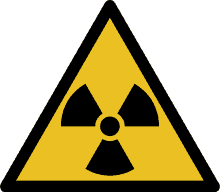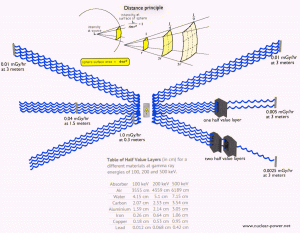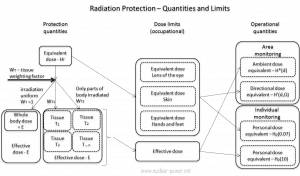Radiation
What is ionizing radiation?
A material is defined as a substance (most often a solid, but other condensed phases can be included) intended for certain applications. There is a myriad of materials around us – they can be found in anything from buildings to spacecraft.
Key Facts
- Ionizing radiation has different ionization mechanisms and may be grouped as:
- Directly ionizing. Charged particles (atomic nuclei, electrons, positrons, protons, muons, etc.) can ionize atoms directly through fundamental interaction through the Coulomb force if they carry sufficient kinetic energy.
- Alpha radiation. Alpha radiation consists of alpha particles at high energy/speed. The production of alpha particles is termed alpha decay.
- Beta radiation. Beta radiation consists of free electrons or positrons at relativistic speeds. The production of beta particles is termed beta decay.
- Indirectly ionizing. Indirect ionizing radiation is electrically neutral particles and does not interact strongly with matter.
- Photon radiation (Gamma rays or X-rays). Photon radiation consists of high-energy photons. According to the currently valid definition, X-rays are emitted by electrons outside the nucleus, while gamma rays are emitted by the nucleus. The production of gamma rays is termed gamma decay.
- Neutron radiation. Neutron radiation consists of free neutrons at any energy/speed. This type of radiation can be produced by nuclear reactors or flight, and neutrons contribute 40 – 80% of the equivalent dose.
- Directly ionizing. Charged particles (atomic nuclei, electrons, positrons, protons, muons, etc.) can ionize atoms directly through fundamental interaction through the Coulomb force if they carry sufficient kinetic energy.
- There are three main types of radiation detectors that record different signals.
- Counter. The activity or intensity of radiation is measured in counts per second (cps).
- Radiation Spectrometer. Spectrometers are devices designed to measure the spectral power distribution of a source.
- Dosimeter. A radiation dosimeter is a device that measures exposure to ionizing radiation.
- In general, there are two broad categories of radiation sources:
- Natural Background Radiation. Natural background radiation includes radiation produced by the Sun, lightning, primordial radioisotopes, supernova explosions, etc.
- Man-Made Sources of Radiation. Manufactured sources include medical uses of radiation, residues from nuclear tests, industrial uses of radiation, etc.

Radiation protection is the science and practice of protecting people and the environment from the harmful effects of ionizing radiation. The International Atomic Energy Agency (IAEA) defines radiation protection as:
“The protection of people from harmful effects of exposure to ionizing radiation, and the means for achieving this”
It is a serious topic not only in nuclear power plants but also in industry or medical centers. According to the IAEA, radiation protection can be divided into three groups:
- occupational radiation protection, which is the protection of workers in situations where their exposure is directly related to or required by their work
- medical radiation protection, which is the protection of patients exposed to radiation as part of their diagnosis or treatment
- public radiation protection, which is the protection of individual members of the public and the population in general
According to the ICRP (Publication 103), the System of Radiological Protection is based on the following three principles:
- Justification. “Any decision that alters the radiation exposure situation should do more good than harm.”
- Optimization of Protection. “Doses should all be kept as low as reasonably achievable, taking into account economic and societal factors.” (known as ALARA or ALARP)
- Dose Limitation. “The total dose to any individual … should not exceed the appropriate limits.”
See also: ICRP, 2007. The 2007 Recommendations of the International Commission on Radiological Protection. ICRP Publication 103. Ann. ICRP 37 (2-4).
The International Commission on Radiological Protection (ICRP) is an independent, international, non-governmental organization created by the 1928 International Congress of Radiology to advance the science of radiological protection for the public. The ICRP is a sister organization to the International Commission on Radiation Units and Measurements (ICRU), which is a standardization body that develops concepts, definitions, and recommendations for the use of quantities and their units for ionizing radiation and its interaction with matter, in particular for the biological effects induced by radiation.
External Dose Uptake
External exposure is radiation that comes from outside our body and interacts with us. In this case, we analyze exposure predominantly from gamma rays since alpha and beta particles, in general, constitute no external exposure hazard because the particles generally do not pass through the skin. The source of radiation can be, for example, a piece of equipment that produces the radiation, like a container with radioactive materials or an x-ray machine. In radiation protection, there are three ways how to protect people from identified external radiation sources:
-

Principles of Radiation Protection – Time, Distance, Shielding Limiting Time. The amount of radiation exposure depends directly (linearly) on the time people spend near the radiation source, and the dose can be reduced by limiting exposure time.
- Distance. The amount of radiation exposure depends on the distance from the radiation source. Like heat from a fire, if you are too close, the intensity of heat radiation is high, and you can get burned. If you are at the right distance, you can withstand there without any problems and are comfortable. If you are too far from the heat source, the insufficiency of heat can also hurt you. In a certain sense, this analogy can be applied to radiation also from radiation sources.
- Shielding. Finally, if the source is too intensive and time or distance does not provide sufficient radiation protection, the shielding must be used. Radiation shielding usually consists of barriers of lead, concrete, or water. Many materials can be used for radiation shielding, but there are many situations in radiation protection. It depends on the type of radiation to be shielded, its energy, and many other parameters. For example, even depleted uranium can be used as good protection from gamma radiation, but on the other hand, uranium is absolutely inappropriate for shielding neutron radiation.
Internal Dose Uptake
If the radiation source is inside our body, we say it is internal exposure. The intake of radioactive material can occur through various pathways, such as ingesting radioactive contamination in food or liquids, and protection from internal exposure is more complicated. Most radionuclides will give you much more radiation dose if they can somehow enter your body than if they remain outside.
Public Exposure and Nuclear Power Plants
It must be noted that radiation is all around us. In, around, and above the world we live in. It is a part of our natural world that has been here since the birth of our planet. There are radioactive isotopes in our bodies, houses, air, water, and the ground – and we are exposed to radiation from outer space. This radiation is called natural background radiation.
Exposure from nuclear power plants and their fuel cycle belongs to manufactured radiation sources. The most significant source of manufactured radiation exposure to the public is from medical procedures, such as diagnostic X-rays and nuclear medicine. Moreover, according to the United Nations Scientific Committee on the Effects of Atomic Radiation (UNSCEAR), public exposure to radiation resulting from electricity generation by nuclear power plants is just a fraction of coal-powered plants.
See also: SOURCES, EFFECTS, AND RISKS OF IONIZING RADIATION, UNSCEAR 2016. ISBN: 978-92-1-142316-7.
